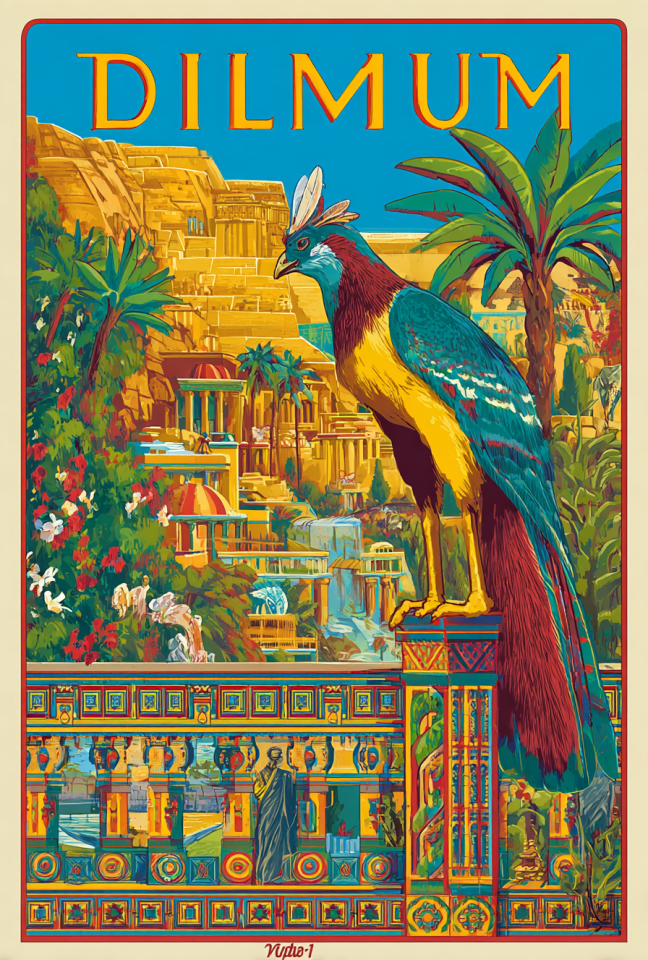Dilmun is the untouched realm, the bright and incorruptible threshold of creation — a place where death never walked and shadow had no name. Rooted in Sumerian spiritual memory, Dilmun is not a lost city or a forgotten myth, but a true Divine Realm that once served as both cradle and mirror of mortal life before the descent of chaos. It is the domain of purity and first form, where all things began in luminous stillness and where the divine met the emerging world face to face. Though once near to mortal understanding, it has long since withdrawn behind the Veil, its gates sealed as humanity turned from original harmony.
Landscape and Essence
Dilmun unfolds as a realm of radiant equilibrium — a land without disease, famine, or fear. Its waters are sweet and eternal, flowing in concentric layers from a central spring said to emerge from the heart of Abzu, the subterranean sea. The land is flat and fertile, bathed in an unwavering golden light that has no source and casts no shadow. Trees bloom endlessly, yet never wither; stone structures hum with subtle vibrations of order, their walls alive with cuneiform patterns that shift with divine breath. The very air is fragrant with the scent of pure existence — not floral or spice, but a clarity that awakens forgotten truths. Time does not pass here — it gathers, pools, and waits.
Inhabitants
Dilmun is not populous in the way other realms are. Its primary caretakers are beings of high purity: luminous entities shaped by principle, not personality. These include the *Anunna*, emissaries of divine law, and *me*-bound spirits who maintain the order of creation. At the realm’s quiet center resides Ninhursag, the Great Mother, whose presence radiates both fertility and stillness. Enki, god of wisdom and subterranean waters, maintains the hidden flows that nourish the realm from below. Mortals do not dwell here — at least not anymore. Long ago, it is said that select humans of immense purity were permitted to rest here briefly in deathless serenity, but as the Mortal Realm turned to ambition and war, even these rare pilgrimages ceased.
Cultural Significance
In Sumerian cosmology, Dilmun was remembered as a pristine origin — a place from which divine order and mortal life both emerged. It was not thought of as a heaven or afterlife, but as a *before-place*, a mirror of the world as it should be. Myths of creation, like those of Ninhursag and Enki, framed Dilmun as the site where humanity’s moral and biological nature was shaped. Temples to these deities often included sealed inner sanctums that mirrored Dilmun’s silence, and rituals of purification were said to call echoes of it forth. Over time, as city-states and priesthoods rose in complexity, the knowledge of Dilmun faded from practice — but never from the deep cultural memory.
Role in the Divine Realm
Dilmun functions as the metaphysical east — the place of first light, of emergence, of potential unstained by consequence. Unlike realms devoted to justice, transformation, or union, Dilmun is not concerned with the fate of souls or the balance of cosmos; it preserves *what was*. It is the original code of life — the uncorrupted kernel of existence from which divine law, natural rhythm, and moral clarity sprang. Its presence is necessary not because it acts, but because it *remains*. If it were lost, all other realms would drift without foundation. It is the sacred template, the echo of the first breath.
Interactions with Other Realms
Dilmun once sat on the edge of many things — the sea, the mortal world, the divine courts. It was a liminal place, half-reflected in the physical world through sacred islands, temple-gardens, and the earliest forms of writing and law. For a time, prophets and dreamers could glimpse its shores; rites of intense purification could thin the Veil briefly. But as human societies drew further from natural law and as divine attention turned to newer crises, the gates of Dilmun were closed. Unlike realms of judgment or reward, Dilmun did not seal itself in anger — it simply became inaccessible, too pure to tolerate distortion. Now, only Ninhursag and Enki may pass freely, and even their movements are rare and purposeful.
















